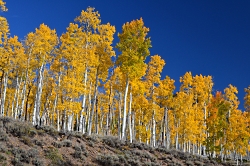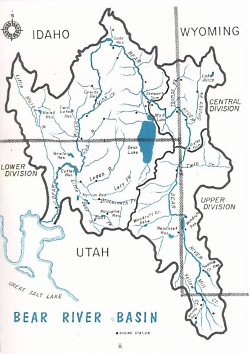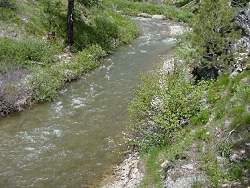
Image courtesy USDA Forest Service
J. Zapell, Photographer
Pando, a sprawling aspen colony and the world’s largest discovered organism, is dying. On the lip of Fish Lake in Central Utah, Pando germinated from a seed the size of a grain of sand thousands of years ago. Now he sprawls over a hundred acres with approximately 47,000 trunks. The combination of the trunks and the extensive root system has Pando weighing in at around 13 million pounds. This giant male, which might be one of the oldest living organisms on the planet, is also prone to disease, wanted by humans to burn in stoves, and targeted by ungulates as a food source. And although Pando consists of literally tons of mature, geriatric trees, there aren’t many young volunteers replacing old trees that die.
Dr. Paul Rogers, a Utah State University scientist who’s trying to save Pando, explained the problem to me while we searched for new growth and deer scat on Pando. He said it would be like depending on a room filled with 90-year-olds to repopulate and save the human race—it’s possible, but not likely.
The age of the current mature trees that make up Pando is about 110-120 years. These ages are gleaned from a tree coring device called a borer. This information combined with others findings show that Pando took a turn for the worse about when Anglo-Americans showed up in central Utah. As they hunted apex predators like bears, wolves and mountain lions, populations of ungulates such as deer and elk increased. White settlers also added other ungulates—sheep, cows, and horses—to the ecosystem. Both domestic and wild ungulates feast on young, nutrient-filled Aspen trees. Which makes it so Pando can’t recolonize himself.
I asked Rogers if the reason he wanted to save Pando was because it was the superlative organism—the oldest and biggest on the globe, and he was quick to correct me. He questions the accuracy of age estimates for Pando based on current available science. And he believes there may even be larger aspen colonies, but we just haven’t found them yet. We know about Pando partially because a paved road goes right over his spine and partially because he almost touches Fish Lake. Rogers says he’s interested in saving Pando because the existence of this huge organism supports many dependent species and it likely holds lessons for sustainable cohabitation of this planet. As an afterthought he added, “If the colony dies on our watch, we’re doing something majorly wrong.”
There is hope for Pando. Aspen do two things really well: die and repopulate. In recent years, efforts have been implemented to preserve Pando. Paradoxically, some sections have been clear cut or burned to stimulate growth. Both techniques have produced positive results, but not enough. It seems the simplest solution to this problem might be the best—protect it from foraging ungulates. Eight-foot deer fences now encircle parts of Pando. Outside the fences, there are no new trees. Inside, however, green shoots can be seen pushing up from the dry ground.
This is Russ Beck for Wild About Utah.
Credits:
Photo: Courtesy USDA Forest Service, J Zapell, Photographer
Text: Russ Beck
Sources & Additional Reading
Pando-(I Spread), Fishlake National Forest, USDA Forest Service, https://www.fs.usda.gov/detail/fishlake/home/?cid=STELPRDB5393641
Pando-The World’s Largest Organism, Holly Strand, Wild About Utah, Sept 3, 2010, https://wildaboututah.org/pando-the-worlds-largest-organism/
Utah State Tree – Quaking Aspen, Utah’s Online Library, https://onlinelibrary.utah.gov/research/utah_symbols/tree.html [Accessed May 15, 2017] See also https://onlinelibrary.utah.gov/utah/symbols/
WESTERN ASPEN ALLIANCE is a joint venture between Utah State University’s College of Natural Resources and the USDA Forest Service Rocky Mountain Research Station, whose purpose is to facilitate and coordinate research issues related to quaking aspen (Populus tremuloides) communities of the west. https://www.western-aspen-alliance.org/
DeWoody J, Rowe C, Hipkins VD, Mock KE (2008) Pando lives: molecular genetic evidence of a giant aspen clone in central Utah. Western North American Naturalist 68(4), pp. 493–497. https://digitalcommons.usu.edu/aspen_bib/3164
Grant, M., J.B. Mitton, AND Y.B. Linhart. 1992. Even larger organisms. Nature 360:216. https://www.nature.com/nature/journal/v360/n6401/abs/360216a0.html
Grant, M. 1993. The trembling giant. Discover 14:83–88. Abstract:https://www.bioone.org/doi/abs/10.3398/1527-0904-68.4.493
Habeck, R. J. 1992. Sequoiadendron giganteum. In: Fire Effects Information System, [Online]. U.S. Department of Agriculture, Forest Service, Rocky Mountain Research Station, Fire Sciences Laboratory (Producer). Available: https://www.fs.fed.us/database/feis/ [Accessed September 2, 2010].
Mock, K.E., C . A. Rowe, M. B. Hooten, J. DeWoody and V. D. Hipkins. Clonal dynamics in western North American aspen (Populus tremuloides) Molecular Ecology (2008) 17, 4827–4844 https://digitalcommons.usu.edu/wild_facpub/163/
Maffly, Brian, A year after southern Utah’s Brian Head Fire, the aspens are bouncing back in a surprising way that could strengthen the forest, The Salt Lake Tribune, Oct 22, 2018, https://www.sltrib.com/news/environment/2018/10/22/year-after-southern/
The Associated Press, Study finds huge aspen grove continues to decline, The Salt Lake Tribune, Oct 22, 2018,
https://www.sltrib.com/news/2018/10/22/study-finds-huge-aspen/
Davis, Nicola, Sound artist eavesdrops on what is thought to be world’s heaviest organism, The Guardian, May 10, 2023, https://www.theguardian.com/environment/2023/may/10/sound-artist-eavesdrops-on-what-is-thought-to-be-worlds-heaviest-organism-pando-utah
The Sweet Song Of The Largest Tree On Earth, Science Friday, National Public Radio, May 12, 2023, https://www.sciencefriday.com/segments/listen-to-the-pando-largest-tree/


